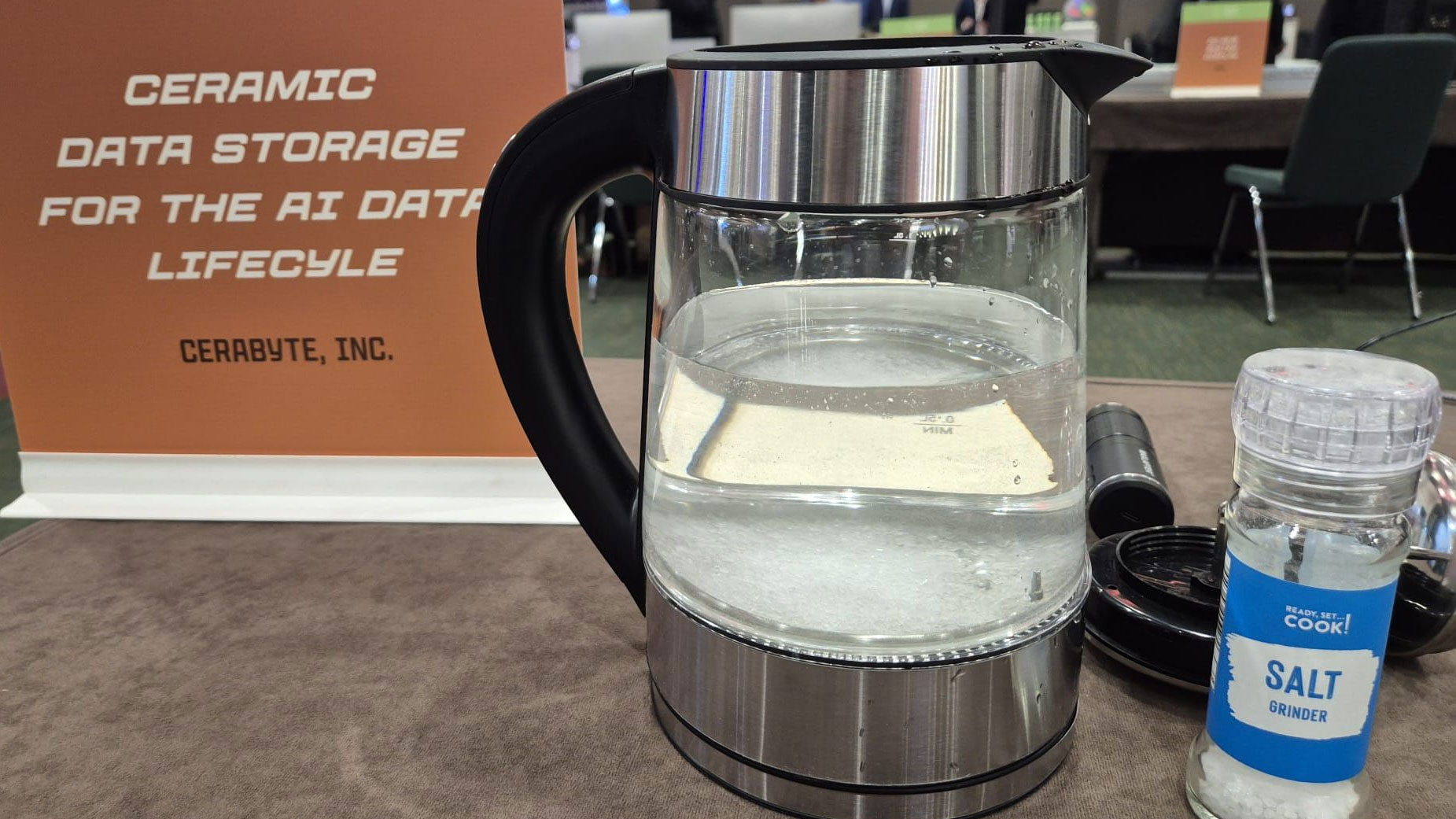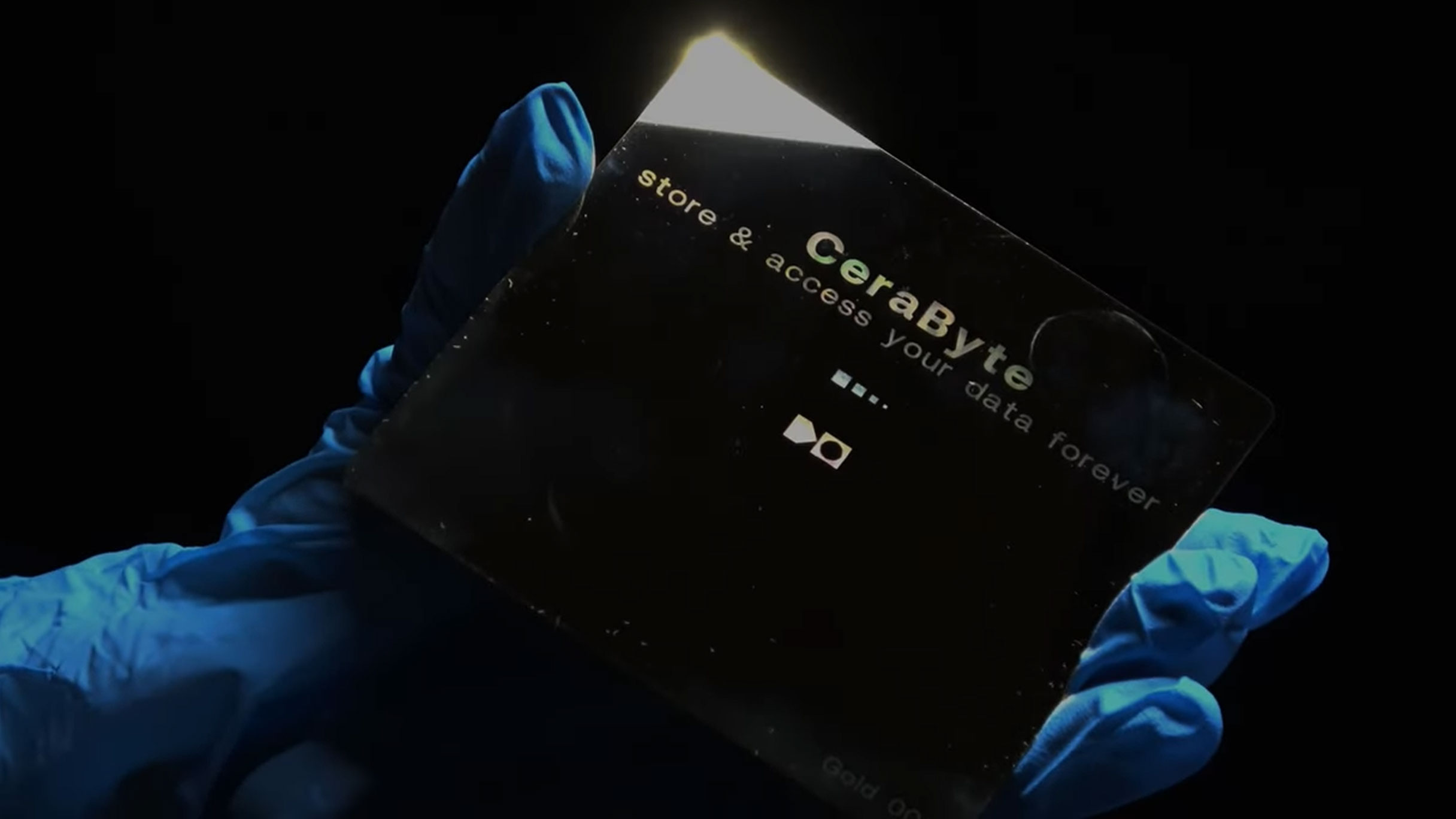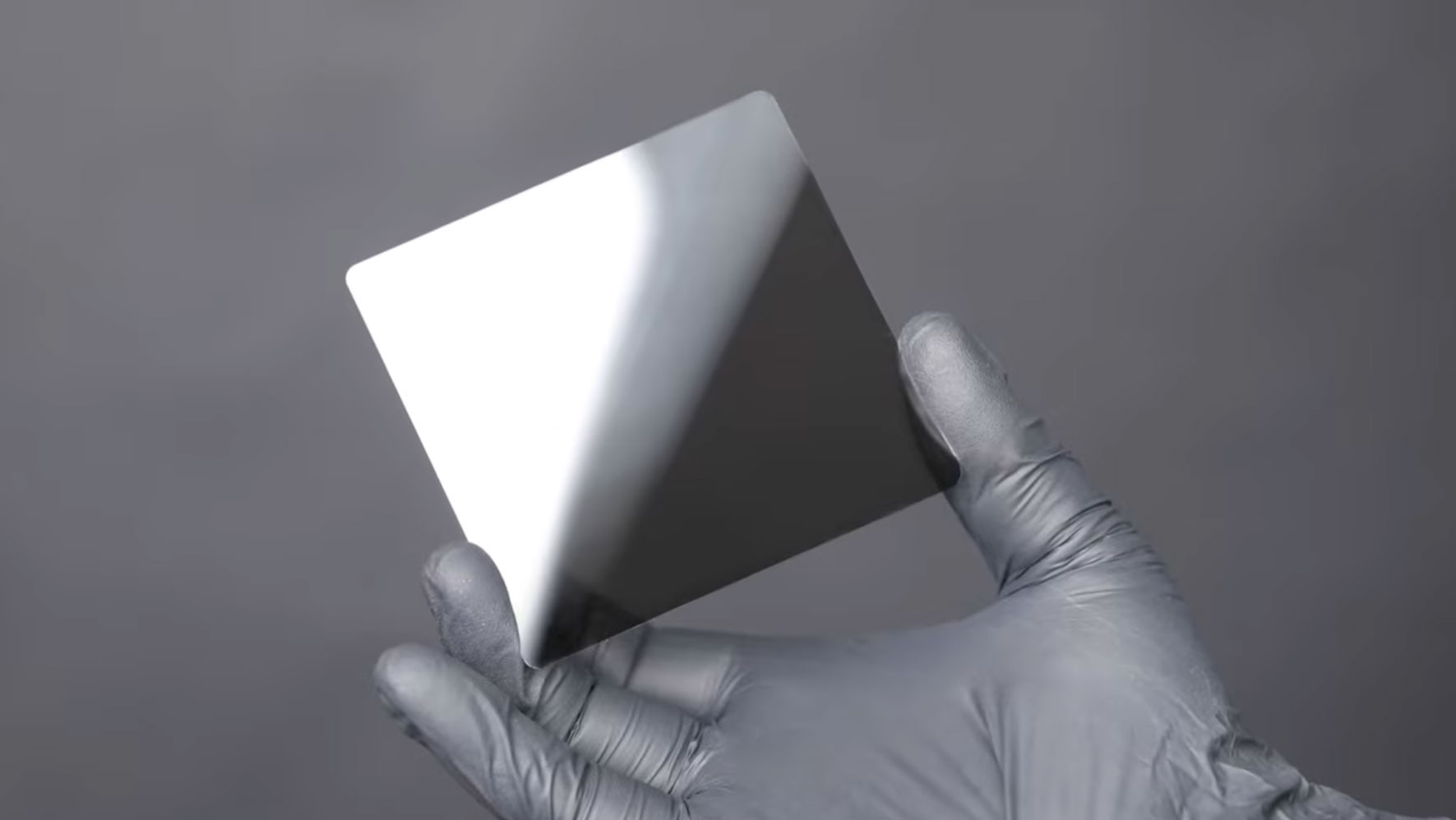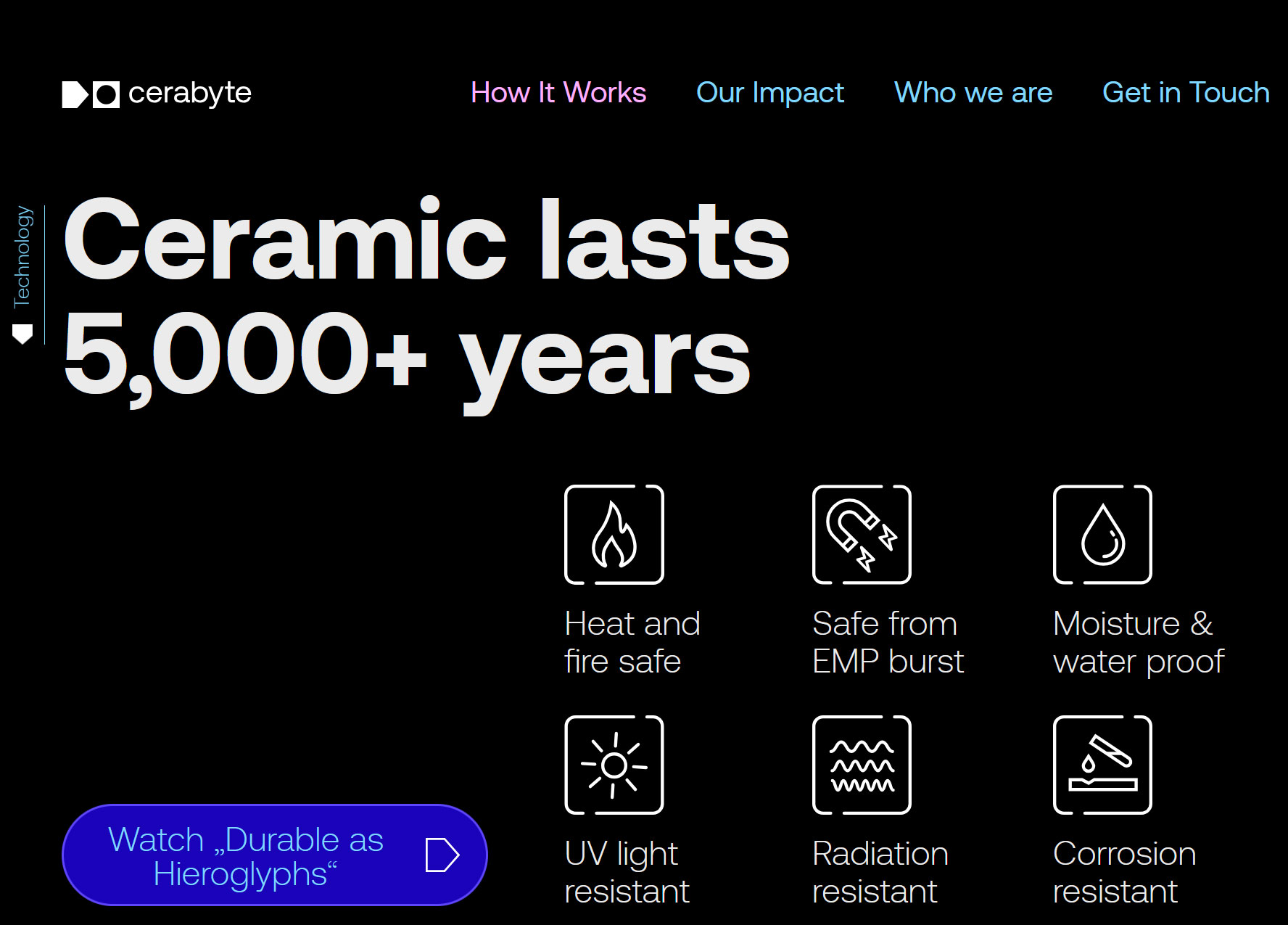Storage device boiled in salt water, then grilled in an oven as proof of durability — Cerabyte's glass storage media claimed to be ultra-rugged
Cerabyte has previously stated its archival glass storage has a 5,000 year lifespan.

Storage startup Cerabyte has shared a video in which it torture tests its memory media. The firm took a sliver of its archival glass storage and boiled it in a kettle filled with salt water (100C, 212F), then, for good measure, it grilled it in a pizza oven (250C, 480F). The durability demo confirms that the media was unscathed after this process, and the data on the Cerabyte media remained “100% intact.”
A demo similar to the embedded video below occurred during the recent Open Compute Project (OCP) summit in Dublin, Ireland. While Cerabyte didn’t seem to pack their toaster for the Irish event, the salt water boiling test was extended over several days. It was noted that the kettle had begun to corrode after 24 hours of hot, salty agitation.
Cerabyte has developed this entertaining shtick to maintain interest in its archival glass storage, which we highlighted on Tom’s Hardware last July. Founded in Germany in 2022, Cerabyte aims to revolutionize data storage by commercializing a data storage medium “as durable as hieroglyphs.” That might be an understatement, if Cerabyte’s touted 5,000-year integrity claim turns out to be accurate (stay tuned for an update).
The ceramic-on-glass material Cerabyte uses in these durability tests stores data imprinted via femtosecond laser nanoscale holes in a ceramic medium 50 to 100 atoms thick. The ultra-thin 9cm square glass chips are written to at a rate of two million bits per laser pulse and can store up to 1GB of data on either surface.


There’s no spooky science behind the durability. Glass is naturally resistant to aging in good 'cold storage' conditions. And, as the Cerabyte trade show demos show, it can shrug off being boiled in salt water for extended periods, or even being severely toasted.
We wouldn’t expect glass-based storage to get corrupted at temperatures much lower than its melting point (around 1,400 degrees Celsius or 2,552 degrees Fahrenheit). Still, we aren’t sure about the unspecified ceramic layer or the interface/bonding between these materials. We also aren’t sure how durable Cerabyte’s ultra-thin media would be if subjected to any impact or shocks. Still, it is naturally resistant to corruption from other common accidents and acts of God that involve fire, water, radiation, or EMP.
Going forward, Cerabyte hopes to reduce media costs to less than $1 per TB by 2030. It isn’t all about glass slide-based storage, either. CeraTape is on its roadmap, and each tape targets storage of an exabyte of data.
Get Tom's Hardware's best news and in-depth reviews, straight to your inbox.
Follow Tom's Hardware on Google News to get our up-to-date news, analysis, and reviews in your feeds. Make sure to click the Follow button.

Mark Tyson is a news editor at Tom's Hardware. He enjoys covering the full breadth of PC tech; from business and semiconductor design to products approaching the edge of reason.
-
passivecool If it is like a CD / DVD (youngsters, ask your parents about this laser-engraved metal layer packed in plastic)Reply
then it is great as long as there are devices around to read them.
I found my (pretty brilliant, I'm sure) college papers on floppies the size of a small pizza.
I threw them away. No way to capture the data.
Okay, if an alien species comes 1000 years after we have eradicated ourselves and are /really/ curious, they will figure it out. ... but that is not really the case scenario I have in mind when buying storage.
But if it is ripe and cheap then there will surely be lots of usages that i would surely support.
They can put the construction manual+IP on a metal disk in a satellite in orbit as a backup. -
usertests Reply
The problem is that there is no clear plan to bring any new storage mediums to consumers. They are all focused on enterprise. Hollywood wants to keep consumers hooked on streaming with no more physical media.passivecool said:If it is like a CD / DVD (youngsters, ask your parents about this laser-engraved metal layer packed in plastic)
then it is great as long as there are devices around to read them.
I found my (pretty brilliant, I'm sure) college papers on floppies the size of a small pizza.
I threw them away. No way to capture the data.
That's bad since putting it into the hands of hundreds of millions of people would result in a lot of independent archiving of information, with many readers spread across the world, easily obtainable even after a global calamity. Instead, we're seeing optical drives disappearing completely, with DVD drives going away and Blu-ray never having caught on in PCs.
$1/TB sounds great, but it's less great if the read/write machine costs $10,000. Maybe I'm being pessimistic, but for now, there's no relevance to most people. -
USAFRet Reply
The other half of that, is that (most) consumers don't seem to want local storage.usertests said:The problem is that there is no clear plan to bring any new storage mediums to consumers.
Small thin laptops, phone, tablet....all content consumption devices, with the content stored elsewhere that the user doesn't have to manage. -
heffeque Reply
I don't know what you mean. My experience is that a lot of people have an external USB drive for backups... and some even have a NAS (be it a basic NAS, or more advanced NAS, depending on how tech-savvy the person is).USAFRet said:The other half of that, is that (most) consumers don't seem to want local storage. -
USAFRet Reply
And my experience, apart from me, is that they do not have that.heffeque said:I don't know what you mean. My experience is that a lot of people have an external USB drive for backups... and some even have a NAS (be it a basic NAS, or more advanced NAS, depending on how tech-savvy the person is).
Not even for backups.
Family members, coworkers, etc, etc....
My NAS is a bit over 100TB available space.
My backup routine is quite comprehensive.
Even among people here at Tom's.....no backup, no external storage.
Daily, we see "Oh My!! Please help me recover my data!!" -
derekullo If they can scale up from 1 gigabyte on a side to 1 terabyte on a side and get the speed up to 2 gigabytes a second (i'm assuming for both read and write) then they could really upend the storage market at least for businesses with large data requirements and data centers.Reply
They don't mention if data is able to be rewritten which I am curious about ... how do you unhole a hole? lol
At sufficient speed it may actually be cheaper to simply replace with another $1 piece of ceramic and rewrite all data ... but that is just speculation.
https://www.cerabyte.com/wp-content/uploads/2025/02/Cerabyte-White-Paper-2-25.pdf
Extraordinary claims require extraordinary evidence -
heffeque Reply
I have to admit... a friend of mine did the effort of doing backups of her stuff on a pen-drive (which is better than nothing), but the pen drive was a cheap fake counterfeit pen-drive that announced more capacity than it really had.USAFRet said:And my experience, apart from me, is that they do not have that.
Not even for backups.
Family members, coworkers, etc, etc....
My NAS is a bit over 100TB available space.
My backup routine is quite comprehensive.
Even among people here at Tom's.....no backup, no external storage.
Daily, we see "Oh My!! Please help me recover my data!!"
Se was writing stuff in it, and it was overwriting her old stuff without her knowledge (she didn't check to open old stuff to see if it was still there... why wouldn't it, right?). Good thing she still had most stuff on her laptop, but she did lose some of it.
A shame that she had a fairly good idea, but so badly executed.
Never use cheap USB drives! More often then not they're terrible in every single way possible!
Though I have to add something else: pen-drives and SSD are terrible for cold-storage. They mostly suffer from severe bit-rot when not powered on for months (sometimes even weeks). -
Rob1C The problem with tape https://en.wikipedia.org/wiki/Linear_Tape-Open is that an LTO-9 drive costs several thousand dollars, and an LTO-10 drive isn't backwards compatible and even more expensive.Reply
Where you win (if you don't consider this a loss) is that 45 TB (LTO-9) tapes are ~U$150 (so a bit more than U$3 / TB). LTO-10 tapes cost a bit more than twice as much, and aren't backwards compatible.
The losing part is that a dozen tapes will hold half a petabyte (though it's best practice to have three copies, so triple the cost) at 3*150*12=U$5400 plus several thousand for the drive. If you only want three tapes that's U$450 plus several thousand dollars (impractical).
So tape is probably only for a medium sized business, that has need for over one hundred tapes.
---
I expect that any of these proposed replacements for tape will have drive costs approximately the same as tape, maybe we'll be lucky and it will only cost half as much.
But even if the storage media is one tenth the cost of LTO-10 you'll still need to buy a few dozen media to justify the cost of the drive; and then you have more capacity that you family and neighbors could use (in almost all cases).
So anything other than SSDs and HDs seems impractical for the consumer. An SSD backed up by a few HDs with spares is bound to last over 30 years; by which point another brand new greatest solution will be proposed, making whatever is finalized this decade completely obsolete.
Don't just reply that I'm wrong, let's hear your better idea.
